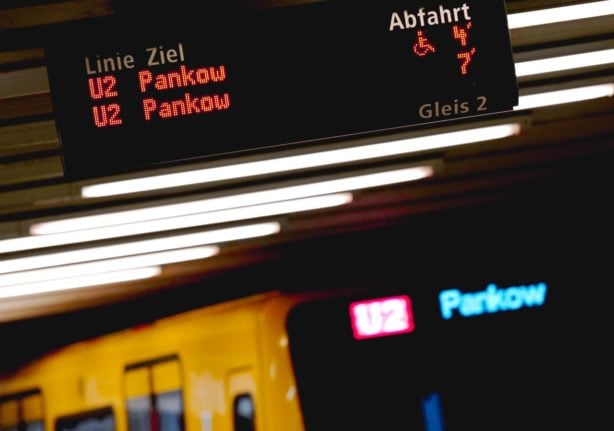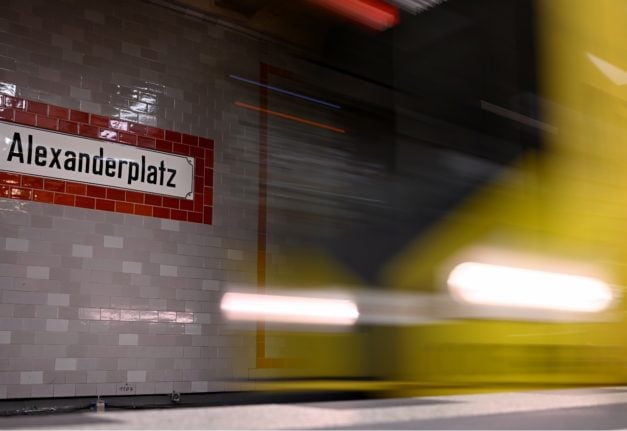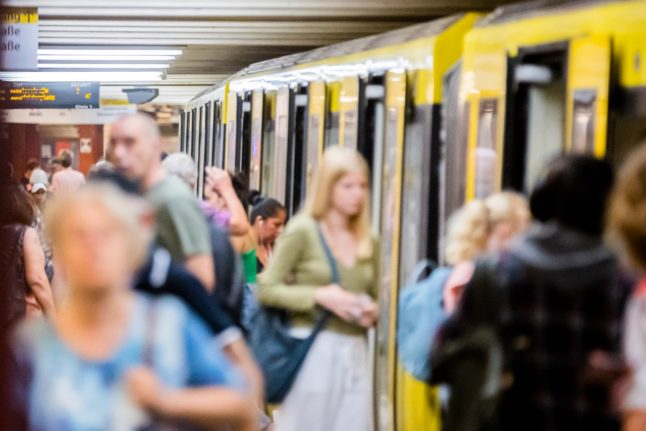REVEALED: How Berlin is planning to dramatically expand its U-Bahn network

The Berlin Senate is considering a wide-ranging expansion of the capital's U-Bahn network - including a brand new line connecting Alexanderplatz and Weißensee.
Whether it's travelling to Pankow with the U9 or hopping on the U7 all the way to BER Airport, Berlin's underground transport network could look very different in the future.
According to recent media reports, Berlin's transport senator is mulling over extensive new plans to develop brand new U-Bahn lines throughout Berlin and widen out existing routes to the outer districts of the capital.
"Berlin needs strong public transport," said new transport senator Manja Schreiner (CDU). "The expansion of networks and services is a decisive key to achieving climate protection goals, strengthening the business community and developing the German capital as a livable metropolis for all people."
On the table are multiple new projects that could be undertaken over the next decade or so to develop public transport in Germany's capital - and particularly outside of the city centre.
The U-Bahn network currently encompasses 147 kilometres and 175 stations, but according to the Berlin's current governing coalition of the Christian Democratic Union (CDU) and the Social Democrats (SPD), this is increasingly out of step with the rapidly growing city.
Here are some of the projects that could come to fruition in the coming years. A map of the proposed changes created by Tagesspiegel can be found here.
U0 - the 'new' Ringbahn
Berlin's S-Bahn 'Ring' is at the heart of the current transport network and is often seen as a dividing line between the city centre and the suburbs.
But the new 'outer' ring envisioned by the Senate would fulfil a different function, connecting stations well beyond the current S-Bahn Ring, including Weißensee, Jungfernheide, Steglitz and Marzahn.
At the moment, these plans are still under review - and given that extending the U-Bahn network by a single station can take a number of years - we may be waiting a number of decades before the U0 becomes a reality.
U1 - Heerstraße to Antonplatz
The U1 used to be one of the most straightforward U-Bahn lines in the Berlin network: running in a straight line through Kreuzberg from Uhlandstraße in Charlottenburg to Warschauer Straße in Friedrichshain. In recent years, the extension of the U3 to run along the same network has better connected those in Kreuzberg-Friedrichshain with the southwest of the city.
Proposals for the future expansion of the underground network would see the U1 stretching out to the west as far as Spandau and expanding north into Weißensee.
READ ALSO: REVEALED: Germany's longest regional train journeys with the €49 ticket
U2 - Falkenhagener Feld to Pankow Kirche
The 'central' line that currently runs from Ruhleben on the outskirts of Spandau to Pankow's S- and U-Bahn could be extended to the west and the northeast in future so that it stretches as far at the state border in the west and up to Pankow Altstadt in the northeast.

A U2 U-Bahn train pulls in at Pankow station. Photo: picture alliance/dpa | Monika Skolimowska
U3 - Düppel-Kleinmachow - Falkenberg
Taking the U3 to the deepest darkest reaches of Lichtenberg or as far as the S-Bahn in Zehlendorf could be a reality in the future if plans to turn the line into a southwest to northeast connection are realised.
At present, however, the plans are far more modest, with the Senate setting it sights on an extension in the southwest from Krumme Lanke to Mexicoplatz.
"The next stage will be the economic feasibility study, which should get underway this year," said Schreiner. "The groundbreaking ceremony for the extension of the U3 to Mexikoplatz is expected for the end of 2024. The construction time is estimated at five years. That would mean that the next new section of the metro can go into operation in the early 2030s."
U4 - Appenzeller Straße - Glambecher Ring
If you're not quite sure where the U4 is, it could be because this tiny line only connects a few stations in Schöneberg from Nollendorfplatz to Innsbrucker Platz. But the grand vision set out by BVG would see it stretch almost as far as Teltow in the south and to the outer end of Lichtenberg - pretty much the border of Brandenburg - in the northeast.
It's fair to say that this is unlikely to be done anytime in the next few decades.
U5 - Jungfernheide - Hönow
The most recent extensions to Berlin's U-Bahn network created a 'tourist' line from Alexanderplatz to Hauptbahnhof. Previously, the U5 simply splayed out to the east from Alexanderplatz into Friedrichshain and Lichtenberg.
The future vision for the U5 would see it extend further to the west through Moabit as far as Jungfernheide, where it would connect with the S-Bahn.

Berlin Alexanderplatz U-Bahn station. Photo: picture alliance/dpa | Monika Skolimowska
U6 - Alt-Tegel - Nahariyastraße
Perhaps the least dramatic extensions to the U-Bahn network would be to the U6, which would continue to run to Alt-Tegel in Reinickendorf in the north but would simply extend beyond Tempelhof and Mariendorf in the south to reach the state border.
U7 - Gatower Straße - Flughafen BER
Berlin's new(ish) airport is well connected to S-Bahn and regional train lines, but at the moment BVG passengers have to rely on a combination of the underground and a bus.
That could all change in the future if the idea to extend the U7 down to BER Airport becomes a reality - and according to the transport senator, an economic feasibility study for this project will begin in 2024.
READ ALSO: Could Germany's newest and fastest ICE train put an end to delays?
"The U7 to BER is an important project from which not only Berliners but also Brandenburgers will benefit," said Schreiner. "The Schönefeld community is growing, and a prosperous economic area has emerged in the vicinity of the BER. It will be made accessible by the underground."
At the other end of the line, meanwhile, an extension south of Rathaus Spandau would see the U7 connect with the extended U1 near the state border in the west.
U8 - Märkisches Viertel - Bückow Süd
The idea to extend the U8 from Wittenau to Märkisches Viertel in the north isn't a new one - but like many infrastructure projects in cash-strapped Berlin, it hasn't quite come to fruition yet.
In the south, meanwhile, the idea is that the U8 would stretch beyond the hipster homelands of north Neukölln and Kreuzkölln to travel the full length of the Bezirk.

Passengers board a U-Bahn train in Berlin. Photo: picture alliance/dpa | Christoph Soeder
U9 - Pankow Heinersdorf - Buckower Chaussee
One of the major issues with the current U-Bahn network that the Senate is keen to solve is the dearth of transport connections in the northeast of the city. Alongside the extension to the U2, one way the transport senator is considering improving this is to expand the U9 beyond Osloer Straße up into Pankow Heinersdorf.
This new U9 line would connect with the U0 and potentially the S-Bahn and could also meet with the extended U2 at Pankow Kirche.
"The extension of the U2 in Pankow would also be conceivable and the further construction of the U9 beyond Osloer Straße into Pankow territory is a serious option," Schreiner summarised. "We are also talking about the possible extension of the S75, which currently still ends in Wartenberg, to the north - and of course the tram plays a roll as well."
U10 - Alexanderplatz to Weißensee
Until now simply a 'phantom line' on the U-Bahn network, the U10 is an idea that resurfaces time and time again. Now, however, the Senate is considering a feasibility study so see if a brand new line from Alexanderplatz to Weißensee would be doable.
This would encompass a number of new U-Bahn stations including Am Friedrichshain, Marienburger Straße, Danziger Straße, Greifswalder Straße, Gürtelstraße and Falkenberger Straße, and could even extend out to Karow or Falkenberg in the east and join up with the U3/U1 to Kurfürstendamm in the west.
READ ALSO: Which German cities have the fewest S-Bahn delays?
When will all this be done?
That's an open question at the moment. So far, Berlin's transport operator BVG has set out the above plans in an unpublished paper, meaning most aren't set in stone yet.
With around 2.2 km of extended U-Bahn track costing an estimated half a billion euros, there are also major questions about affordability.
However, projects like the extension of the U3 to Mexicoplatz look set to go ahead and others - such as the U2 and U9 extensions - are being investigated to see if they could potentially be feasible.
In other words: watch this space.
Comments
See Also
Whether it's travelling to Pankow with the U9 or hopping on the U7 all the way to BER Airport, Berlin's underground transport network could look very different in the future.
According to recent media reports, Berlin's transport senator is mulling over extensive new plans to develop brand new U-Bahn lines throughout Berlin and widen out existing routes to the outer districts of the capital.
"Berlin needs strong public transport," said new transport senator Manja Schreiner (CDU). "The expansion of networks and services is a decisive key to achieving climate protection goals, strengthening the business community and developing the German capital as a livable metropolis for all people."
On the table are multiple new projects that could be undertaken over the next decade or so to develop public transport in Germany's capital - and particularly outside of the city centre.
The U-Bahn network currently encompasses 147 kilometres and 175 stations, but according to the Berlin's current governing coalition of the Christian Democratic Union (CDU) and the Social Democrats (SPD), this is increasingly out of step with the rapidly growing city.
Here are some of the projects that could come to fruition in the coming years. A map of the proposed changes created by Tagesspiegel can be found here.
U0 - the 'new' Ringbahn
Berlin's S-Bahn 'Ring' is at the heart of the current transport network and is often seen as a dividing line between the city centre and the suburbs.
But the new 'outer' ring envisioned by the Senate would fulfil a different function, connecting stations well beyond the current S-Bahn Ring, including Weißensee, Jungfernheide, Steglitz and Marzahn.
At the moment, these plans are still under review - and given that extending the U-Bahn network by a single station can take a number of years - we may be waiting a number of decades before the U0 becomes a reality.
U1 - Heerstraße to Antonplatz
The U1 used to be one of the most straightforward U-Bahn lines in the Berlin network: running in a straight line through Kreuzberg from Uhlandstraße in Charlottenburg to Warschauer Straße in Friedrichshain. In recent years, the extension of the U3 to run along the same network has better connected those in Kreuzberg-Friedrichshain with the southwest of the city.
Proposals for the future expansion of the underground network would see the U1 stretching out to the west as far as Spandau and expanding north into Weißensee.
READ ALSO: REVEALED: Germany's longest regional train journeys with the €49 ticket
U2 - Falkenhagener Feld to Pankow Kirche
The 'central' line that currently runs from Ruhleben on the outskirts of Spandau to Pankow's S- and U-Bahn could be extended to the west and the northeast in future so that it stretches as far at the state border in the west and up to Pankow Altstadt in the northeast.

U3 - Düppel-Kleinmachow - Falkenberg
Taking the U3 to the deepest darkest reaches of Lichtenberg or as far as the S-Bahn in Zehlendorf could be a reality in the future if plans to turn the line into a southwest to northeast connection are realised.
At present, however, the plans are far more modest, with the Senate setting it sights on an extension in the southwest from Krumme Lanke to Mexicoplatz.
"The next stage will be the economic feasibility study, which should get underway this year," said Schreiner. "The groundbreaking ceremony for the extension of the U3 to Mexikoplatz is expected for the end of 2024. The construction time is estimated at five years. That would mean that the next new section of the metro can go into operation in the early 2030s."
U4 - Appenzeller Straße - Glambecher Ring
If you're not quite sure where the U4 is, it could be because this tiny line only connects a few stations in Schöneberg from Nollendorfplatz to Innsbrucker Platz. But the grand vision set out by BVG would see it stretch almost as far as Teltow in the south and to the outer end of Lichtenberg - pretty much the border of Brandenburg - in the northeast.
It's fair to say that this is unlikely to be done anytime in the next few decades.
U5 - Jungfernheide - Hönow
The most recent extensions to Berlin's U-Bahn network created a 'tourist' line from Alexanderplatz to Hauptbahnhof. Previously, the U5 simply splayed out to the east from Alexanderplatz into Friedrichshain and Lichtenberg.
The future vision for the U5 would see it extend further to the west through Moabit as far as Jungfernheide, where it would connect with the S-Bahn.

U6 - Alt-Tegel - Nahariyastraße
Perhaps the least dramatic extensions to the U-Bahn network would be to the U6, which would continue to run to Alt-Tegel in Reinickendorf in the north but would simply extend beyond Tempelhof and Mariendorf in the south to reach the state border.
U7 - Gatower Straße - Flughafen BER
Berlin's new(ish) airport is well connected to S-Bahn and regional train lines, but at the moment BVG passengers have to rely on a combination of the underground and a bus.
That could all change in the future if the idea to extend the U7 down to BER Airport becomes a reality - and according to the transport senator, an economic feasibility study for this project will begin in 2024.
READ ALSO: Could Germany's newest and fastest ICE train put an end to delays?
"The U7 to BER is an important project from which not only Berliners but also Brandenburgers will benefit," said Schreiner. "The Schönefeld community is growing, and a prosperous economic area has emerged in the vicinity of the BER. It will be made accessible by the underground."
At the other end of the line, meanwhile, an extension south of Rathaus Spandau would see the U7 connect with the extended U1 near the state border in the west.
U8 - Märkisches Viertel - Bückow Süd
The idea to extend the U8 from Wittenau to Märkisches Viertel in the north isn't a new one - but like many infrastructure projects in cash-strapped Berlin, it hasn't quite come to fruition yet.
In the south, meanwhile, the idea is that the U8 would stretch beyond the hipster homelands of north Neukölln and Kreuzkölln to travel the full length of the Bezirk.

U9 - Pankow Heinersdorf - Buckower Chaussee
One of the major issues with the current U-Bahn network that the Senate is keen to solve is the dearth of transport connections in the northeast of the city. Alongside the extension to the U2, one way the transport senator is considering improving this is to expand the U9 beyond Osloer Straße up into Pankow Heinersdorf.
This new U9 line would connect with the U0 and potentially the S-Bahn and could also meet with the extended U2 at Pankow Kirche.
"The extension of the U2 in Pankow would also be conceivable and the further construction of the U9 beyond Osloer Straße into Pankow territory is a serious option," Schreiner summarised. "We are also talking about the possible extension of the S75, which currently still ends in Wartenberg, to the north - and of course the tram plays a roll as well."
U10 - Alexanderplatz to Weißensee
Until now simply a 'phantom line' on the U-Bahn network, the U10 is an idea that resurfaces time and time again. Now, however, the Senate is considering a feasibility study so see if a brand new line from Alexanderplatz to Weißensee would be doable.
This would encompass a number of new U-Bahn stations including Am Friedrichshain, Marienburger Straße, Danziger Straße, Greifswalder Straße, Gürtelstraße and Falkenberger Straße, and could even extend out to Karow or Falkenberg in the east and join up with the U3/U1 to Kurfürstendamm in the west.
READ ALSO: Which German cities have the fewest S-Bahn delays?
When will all this be done?
That's an open question at the moment. So far, Berlin's transport operator BVG has set out the above plans in an unpublished paper, meaning most aren't set in stone yet.
With around 2.2 km of extended U-Bahn track costing an estimated half a billion euros, there are also major questions about affordability.
However, projects like the extension of the U3 to Mexicoplatz look set to go ahead and others - such as the U2 and U9 extensions - are being investigated to see if they could potentially be feasible.
In other words: watch this space.
Join the conversation in our comments section below. Share your own views and experience and if you have a question or suggestion for our journalists then email us at [email protected].
Please keep comments civil, constructive and on topic – and make sure to read our terms of use before getting involved.
Please log in here to leave a comment.